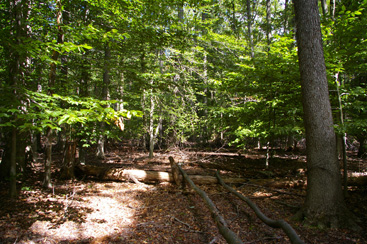Preserved Tract on Princeton Ridge Is Link to a Network of Greenways


ADDING TO THE GREENBELT: A new partnership has added a wooded lot on the Princeton Ridge to a chain of properties that environmentalists hope will form a ring of preserved open space around the town.
(Photo by Eric Tazelaar)
A wooded property on the Princeton Ridge that could have been developed for townhouses has been permanently preserved by a public-private partnership involving the municipality, Mercer County, New Jersey’s Green Acres Program, and the Borden Foundation. Known as the Klepper property, the 4.3-acre lot is just north of Ewing Street with frontage on the east side of Route 206.
Preservation of the wooded tract adds to a collection of lots totaling nearly 30 acres, according to Wendy Mager, president of the Friends of Princeton Open Space (FOPOS). The site is close to the Ricciardi property, which was preserved in 2011 by many of the same partners.
“The property is almost opposite a 32-acre parcel that belongs to the water company and has a significant conservation easement,” Ms. Mager said. “It is well-placed to make a connection to Mount Lucas Road and other preserved properties. It is part of something that Friends of Princeton Open Space has been working on for many years — not just preserving isolated pieces, but preserving a greenbelt that extends around the town.”
The parcel was first brought to Ms. Mager’s attention in 2009 by Princeton planning director Lee Solow. “He pointed out that this would be a really good property to preserve,” she said. “We had been talking about other preservation projects on the ridge. When I tried to get in touch with Anne Klepper, one of the owners of this property, I learned that she had recently passed away. So I got in touch with her daughter.”
Leslie Klepper Arkin, who lives in New York, “didn’t really have much of a connection to the property,” Ms. Mager said. “Her parents had bought it quite a number of years ago. She was really learning from us why we thought it was so important to preserve, and it wasn’t hard to convince her.”
The site includes forests and wetlands that are particular to the environmentally sensitive Princeton Ridge, and is immediately adjacent to other undeveloped lots. “These lots have mature forests and provide an important habitat for some threatened species,” Ms. Mager said. “They are also part of an important system that helps prevent flooding in areas that are down-slope from the ridge.”
The property is part of a parcel that was approved several years ago for a 49-unit development, Princeton Senior Townhomes. Environmentalists including FOPOS and the Stony Brook-Millstone Watershed Association were opposed to the idea. A lawsuit by neighboring property owners resulted in a lower density than originally proposed, and preservation became an option.
The acquisition was completed using FOPOS’s Green Acres grant, grants to FOPOS and the New Jersey Conservation Foundation from the Mercer County open space program, funds from Princeton’s open space tax, and a grant from the Borden Foundation to cover the costs of appraisals, title work, and legal fees.
Ms. Mager said she hopes to talk with the owners of other lots that were part of the proposed development in an effort to persuade them to follow Ms. Klepper Arkin’s example and opt for preservation. “This is not the end of the story,” she said in a press release about the property. “It taught me that you should never give up on a property that is worth preserving. Projects get approved, but not all of them get built, and sometimes there is still a chance to turn things around. I especially appreciate the spirit of conservation and public-mindedness that Leslie Klepper Arkin showed in working with us.”
The property will be owned 65 percent by Princeton, 25 percent by the New Jersey Conservation Foundation, and 10 percent by FOPOS.

